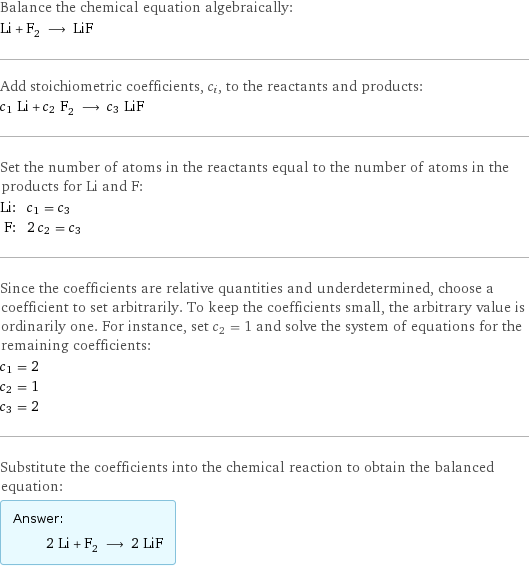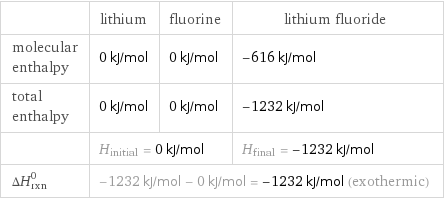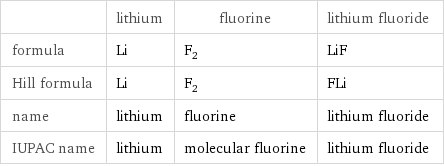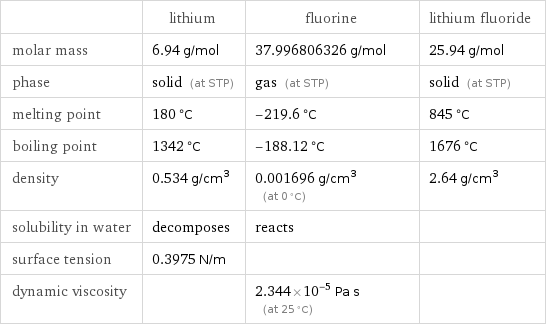Input interpretation

Li lithium + F_2 fluorine ⟶ LiF lithium fluoride
Balanced equation

Balance the chemical equation algebraically: Li + F_2 ⟶ LiF Add stoichiometric coefficients, c_i, to the reactants and products: c_1 Li + c_2 F_2 ⟶ c_3 LiF Set the number of atoms in the reactants equal to the number of atoms in the products for Li and F: Li: | c_1 = c_3 F: | 2 c_2 = c_3 Since the coefficients are relative quantities and underdetermined, choose a coefficient to set arbitrarily. To keep the coefficients small, the arbitrary value is ordinarily one. For instance, set c_2 = 1 and solve the system of equations for the remaining coefficients: c_1 = 2 c_2 = 1 c_3 = 2 Substitute the coefficients into the chemical reaction to obtain the balanced equation: Answer: | | 2 Li + F_2 ⟶ 2 LiF
Structures

+ ⟶
Names

lithium + fluorine ⟶ lithium fluoride
Reaction thermodynamics
Enthalpy

| lithium | fluorine | lithium fluoride molecular enthalpy | 0 kJ/mol | 0 kJ/mol | -616 kJ/mol total enthalpy | 0 kJ/mol | 0 kJ/mol | -1232 kJ/mol | H_initial = 0 kJ/mol | | H_final = -1232 kJ/mol ΔH_rxn^0 | -1232 kJ/mol - 0 kJ/mol = -1232 kJ/mol (exothermic) | |
Equilibrium constant
![Construct the equilibrium constant, K, expression for: Li + F_2 ⟶ LiF Plan: • Balance the chemical equation. • Determine the stoichiometric numbers. • Assemble the activity expression for each chemical species. • Use the activity expressions to build the equilibrium constant expression. Write the balanced chemical equation: 2 Li + F_2 ⟶ 2 LiF Assign stoichiometric numbers, ν_i, using the stoichiometric coefficients, c_i, from the balanced chemical equation in the following manner: ν_i = -c_i for reactants and ν_i = c_i for products: chemical species | c_i | ν_i Li | 2 | -2 F_2 | 1 | -1 LiF | 2 | 2 Assemble the activity expressions accounting for the state of matter and ν_i: chemical species | c_i | ν_i | activity expression Li | 2 | -2 | ([Li])^(-2) F_2 | 1 | -1 | ([F2])^(-1) LiF | 2 | 2 | ([LiF])^2 The equilibrium constant symbol in the concentration basis is: K_c Mulitply the activity expressions to arrive at the K_c expression: Answer: | | K_c = ([Li])^(-2) ([F2])^(-1) ([LiF])^2 = ([LiF])^2/(([Li])^2 [F2])](../image_source/320ad6e975ba6fc5ad93e020e914c6aa.png)
Construct the equilibrium constant, K, expression for: Li + F_2 ⟶ LiF Plan: • Balance the chemical equation. • Determine the stoichiometric numbers. • Assemble the activity expression for each chemical species. • Use the activity expressions to build the equilibrium constant expression. Write the balanced chemical equation: 2 Li + F_2 ⟶ 2 LiF Assign stoichiometric numbers, ν_i, using the stoichiometric coefficients, c_i, from the balanced chemical equation in the following manner: ν_i = -c_i for reactants and ν_i = c_i for products: chemical species | c_i | ν_i Li | 2 | -2 F_2 | 1 | -1 LiF | 2 | 2 Assemble the activity expressions accounting for the state of matter and ν_i: chemical species | c_i | ν_i | activity expression Li | 2 | -2 | ([Li])^(-2) F_2 | 1 | -1 | ([F2])^(-1) LiF | 2 | 2 | ([LiF])^2 The equilibrium constant symbol in the concentration basis is: K_c Mulitply the activity expressions to arrive at the K_c expression: Answer: | | K_c = ([Li])^(-2) ([F2])^(-1) ([LiF])^2 = ([LiF])^2/(([Li])^2 [F2])
Rate of reaction
![Construct the rate of reaction expression for: Li + F_2 ⟶ LiF Plan: • Balance the chemical equation. • Determine the stoichiometric numbers. • Assemble the rate term for each chemical species. • Write the rate of reaction expression. Write the balanced chemical equation: 2 Li + F_2 ⟶ 2 LiF Assign stoichiometric numbers, ν_i, using the stoichiometric coefficients, c_i, from the balanced chemical equation in the following manner: ν_i = -c_i for reactants and ν_i = c_i for products: chemical species | c_i | ν_i Li | 2 | -2 F_2 | 1 | -1 LiF | 2 | 2 The rate term for each chemical species, B_i, is 1/ν_i(Δ[B_i])/(Δt) where [B_i] is the amount concentration and t is time: chemical species | c_i | ν_i | rate term Li | 2 | -2 | -1/2 (Δ[Li])/(Δt) F_2 | 1 | -1 | -(Δ[F2])/(Δt) LiF | 2 | 2 | 1/2 (Δ[LiF])/(Δt) (for infinitesimal rate of change, replace Δ with d) Set the rate terms equal to each other to arrive at the rate expression: Answer: | | rate = -1/2 (Δ[Li])/(Δt) = -(Δ[F2])/(Δt) = 1/2 (Δ[LiF])/(Δt) (assuming constant volume and no accumulation of intermediates or side products)](../image_source/585855f1f1bed5e0fc5ebb67fb1c6796.png)
Construct the rate of reaction expression for: Li + F_2 ⟶ LiF Plan: • Balance the chemical equation. • Determine the stoichiometric numbers. • Assemble the rate term for each chemical species. • Write the rate of reaction expression. Write the balanced chemical equation: 2 Li + F_2 ⟶ 2 LiF Assign stoichiometric numbers, ν_i, using the stoichiometric coefficients, c_i, from the balanced chemical equation in the following manner: ν_i = -c_i for reactants and ν_i = c_i for products: chemical species | c_i | ν_i Li | 2 | -2 F_2 | 1 | -1 LiF | 2 | 2 The rate term for each chemical species, B_i, is 1/ν_i(Δ[B_i])/(Δt) where [B_i] is the amount concentration and t is time: chemical species | c_i | ν_i | rate term Li | 2 | -2 | -1/2 (Δ[Li])/(Δt) F_2 | 1 | -1 | -(Δ[F2])/(Δt) LiF | 2 | 2 | 1/2 (Δ[LiF])/(Δt) (for infinitesimal rate of change, replace Δ with d) Set the rate terms equal to each other to arrive at the rate expression: Answer: | | rate = -1/2 (Δ[Li])/(Δt) = -(Δ[F2])/(Δt) = 1/2 (Δ[LiF])/(Δt) (assuming constant volume and no accumulation of intermediates or side products)
Chemical names and formulas

| lithium | fluorine | lithium fluoride formula | Li | F_2 | LiF Hill formula | Li | F_2 | FLi name | lithium | fluorine | lithium fluoride IUPAC name | lithium | molecular fluorine | lithium fluoride
Substance properties

| lithium | fluorine | lithium fluoride molar mass | 6.94 g/mol | 37.996806326 g/mol | 25.94 g/mol phase | solid (at STP) | gas (at STP) | solid (at STP) melting point | 180 °C | -219.6 °C | 845 °C boiling point | 1342 °C | -188.12 °C | 1676 °C density | 0.534 g/cm^3 | 0.001696 g/cm^3 (at 0 °C) | 2.64 g/cm^3 solubility in water | decomposes | reacts | surface tension | 0.3975 N/m | | dynamic viscosity | | 2.344×10^-5 Pa s (at 25 °C) |
Units
